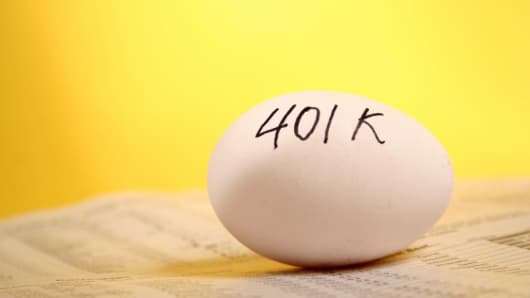Jane Doe never noticed as hundreds of dollars disappeared from her paychecks since she was hired two years ago.
Her company started by taking 3 percent out of every check to put into her 401(k) retirement plan. After one year, Ms. Doe — who is fictitious but typical — got a 1.5 percent raise, but the company diverted most of that into her 401(k). The same thing happened the following January.
The money has been going into an investment called a target-date fund, which Ms. Doe never specifically chose. That fund is programmed to select an array of stocks, bonds and other asset categories based on Ms. Doe's age. As she grows older, the percentages will gradually shift, without any instructions from Ms. Doe.
Theoretically, if this arrangement continues, Ms. Doe will be able to retire in about 35 years with almost enough money to live comfortably. Her paycheck and retirement plan have been on autopilot, because Ms. Doe and her company have tacitly agreed that she cannot be trusted to make the right decisions.
This sort of plan has spread quickly through the 401(k) world in the last six years, and even more growth and varieties are predicted. It is related to a concept sometimes called "libertarian paternalism" — subtly pushing people to make rational choices — that has been applied in other fields, like checkoffs for organ donations on driver's license applications. In the retirement world, it means that employees' money is automatically invested in a savings plan, unless they specifically opt out.
"It plays into the fact that inertia is a very powerful force," said Robert A. Benish, executive director and interim president of the Plan Sponsor Council of America, a trade group for employers. With the automatic features, he said, "you can jump-start someone without pain."
While automation achieves its basic goal of increasing savings, however, it seems to contradict one of the original justifications for 401(k)'s — that individuals want to be in charge of their own retirement planning.
Proponents say that is partly because many conditions have changed since the first 401(k) plans were established three decades ago. Traditional pensions have all but disappeared, markets have become more volatile, wages have stagnated and more research has been done on financial behavior.
"Our view in 1980 was unsophisticated about individual decision makers," said Stephen P. Utkus, director of the Vanguard Center for Retirement Research at Vanguard Group, one of the largest plan administrators.
The automatic features were developed because experts feared that people were not signing up for 401(k) plans on their own initiative, not putting in enough money and not choosing appropriate investments. For instance, Fidelity Investments, the largest administrator, said that among its clients, only 56 percent of eligible employees participated in plans without automatic features versus 90 percent in the automated plans.
Their use got a big boost from changes in federal pension law in 2006, which clarified that auto-enrollment would not violate state withholding laws. Today about half of all plans have at least one type of automation, according to the Plan Sponsor Council of America and others.
The most common features:
- Automatic enrollment for new employees. People are put into the plan when hired, and a portion of their salaries — typically 3 percent — is deducted.
- Automatic escalation. The payroll deduction rises every year, perhaps on the anniversary of the person's starting date or on a universal date like Jan. 1. The standard increase is 1 percent of salary, and companies try to tie this in with a pay raise.
- Automatic investment decisions. The payroll deductions have to be invested in something, so administrators are increasingly using programs like those used for target-date funds, which adjust the investment mix according to the employee's age.
Advocates say all that is not enough. The biggest problem is that too little money is being taken from paychecks.


